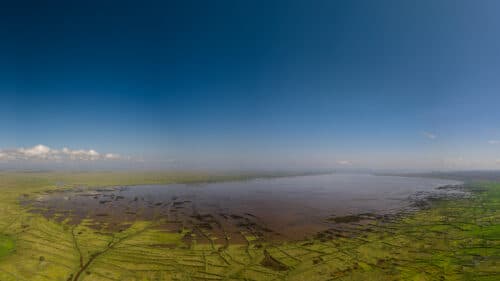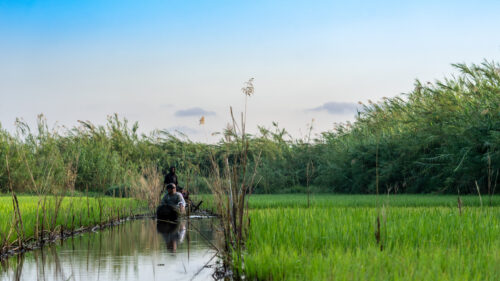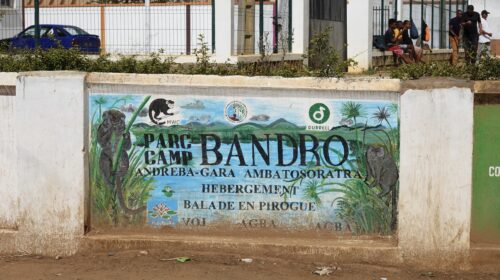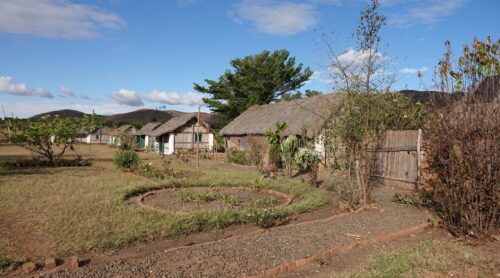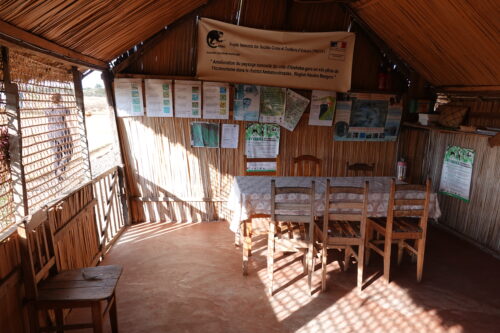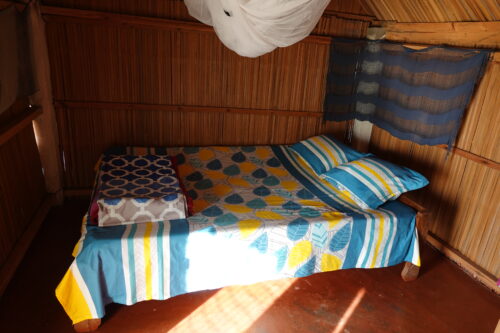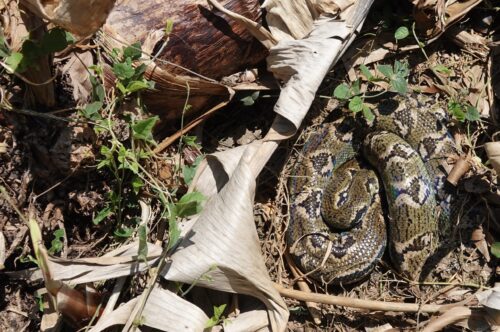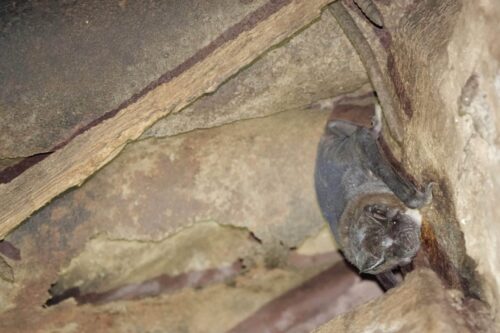In this post, Cheryl Antonucci shares her experience visiting Lake Alaotra and Park Bandro in search of the Lake Alaotra Bamboo Lemur (or Gentle Lemur). Camp Bandro is run by LCN member Madagascar Wildlife Conservation (MWC). Cheryl is a veterinarian and avid mammal watcher who travels the world to see mammals in their natural environments. She has seen 250 species of primates in the wild!
In 2020, the BBC aired a series program called Primates, highlighting some of the well known and lesser known species of primates on the planet. One of the species they highlighted was the Lac Alaotra Bamboo Lemur (Hapalemur alaotrensis), also known as the gentle lemur or the “Bandro” by locals. Deb Bradley, my good friend and host of the Let’s Go Wild podcast, immediately called me after watching the episode and told me we should add a few days to visit this lemur on our upcoming trip to Madagascar.
About Lake Alaotra and the Alaotra Bamboo Lemur
About this Lemur
There is some debate that there is only one species of Bamboo lemur (Hapalemur griseus) with four subspecies. But, it is not up for debate that this is the only primate that spends its entire life on reed beds above the water. Unlike other bamboo lemurs, they also do not eat bamboo, but eat leaves and shoots from papyrus and some other grasses above the lake.
Like many other lemurs females rule and they are cathemeral, being active both day and night. They usually live in small family groups and females carry their young in their mouths until they are strong enough to hold onto their mothers jumping around the reeds. Families also use latrine areas as a common place to urinate and defecate. In my opinion, this is a very special primate indeed!
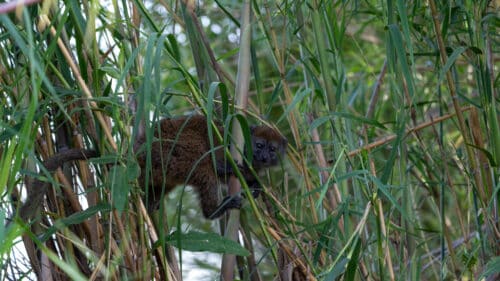
About this Lake
Lake Alaotra is the largest lake in Madagascar and is in one of the richest areas for rice production, which is a huge staple for the human population. It also has a large (declining) fish population. Both these things make the lake a huge draw point for people to live in. However, this is also a downfall for the lake as increasing human populations are rapidly destroying the lake for rice production, burning for fishing access and grazing areas for cattle, and the lemurs themselves are hunted as a protein source.
Conservation of the Alaotra Bamboo Lemur
There are some groups that are trying to work in the area for conservation. One of them, Madagascar Wildlife Conservation, works with NGOs, provides education in local schools and universities, and creates local initiatives to try to ensure the survival of the Bandro. MWC helped to set up Camp Bandro close to the village of Andreba. It is a community based program for tourism that helps provide income for villagers and for projects such as water wells.
The Bandro is in dire need of help.
Listed as critically endangered, there are probably less than 1,000 left. Tourism can definitely help, especially as Camp Bandro is a community run program that brings money back into the area. Plus, it gives extra job opportunities to the local people who help find the Bandro and for the family that takes care of the camp.
Donate to MWC via Conservation AlliesMy Trip to Lake Alaotra
I have always felt that tourism is a vital tool for conservation. This is my experience visiting the lake area.
Getting to Lake Alaotra
Prior to coming to Madagascar, I contacted Brilland Andriamirindra, who runs Madacartours. After talking to Brilland about the possibility of seeing the Bandro, he went to the area and figured out the logistics for us.
So in October of 2023, Brilland along with my friends Deb Bradley and Angiolo Laviziano traveled north from the capital city of Antananarivo along the RN2 and RN 44 highways to the town of Ambatondrazaka. These two highways were in excellent condition and the travel time was roughly 5 hours. We did stop along the way in the town of Moramanga for lunch at a local restaurant.
In Ambatondrazaka, we met our local guide Jonathan Randrianjanaka who is working in the area to help promote Bandro tourism. It then took about 40 minutes to drive to Camp Bandro along flat and for the most part smooth, dirt roads.
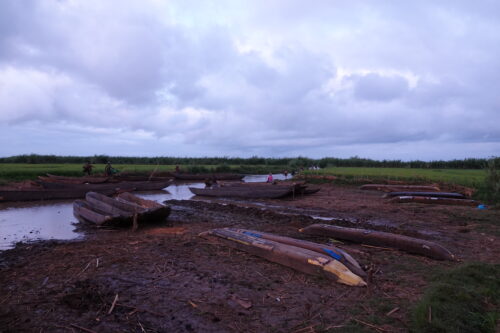
About Camp Bandro
Camp Bandro is in the zone known as Park Bandro along the south east part of the lake. The camp has five comfortable rooms created in the local Sihanaka style, the local ethnic group around the lake. They also have a kitchen area, a bathroom with one western toilet and one eastern with a bucket shower area and a house for the guardians of the camp. The two rooms closest to the kitchen have some electricity. The guardians can also cook all meals for you. People on a strict budget are also able to camp in the grounds by the rooms. When we visited, we were the only people staying there.
We are told that they only receive about 1 tourist group a month.
On the Lake to Spot Bandros
After spending the night in the camp, we woke up before dawn and traveled about 5 minutes to the edge of the lake to meet some of the locals who would be taking us out on pirogues to see the Bandros. There were already a very large number of people walking to this area and setting off in other pirogues to either fish or start working in the rice fields.
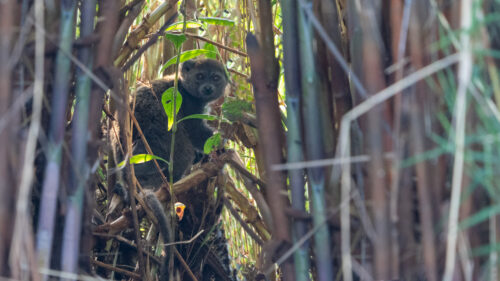
In October the water was low which meant at some points the local guides had to pull us through the water. The guides knew of several areas to see families of Bandro and opted that day to take us to the closest family. After being on a main waterway we were taken into an area of denser reed beds. Two of the local guides then got out of the boat to walk on the reeds, then within 5 minutes they found the family.
With the water being low, the Bandros were also very close at the base of the reeds, so we all got views as the family of three navigated in and out of the reed beds. Going earlier in the year when the water is higher, the Bandros are easier to see. After spending some time with them, we were taken back to the lake edge with some bird watching along the way.
The next day we went back in search for another family of Bandros in a more distant part of the lake. This family proved more a challenge for the locals to find. But, just as we were leaving the area, the family of four was found. One of the members was also slightly higher in the reeds providing better views.
Traveling to Lake Alaotra
If you are planning a trip to Madagascar, add a night or two to see the amazing Lake Alaotra Bamboo Lemur! There is also Durrell’s Vontsira and an undescribed mouse lemur in this area, however both are difficult to see.
- Camp Bandro Website and Facebook
- Donate to Madagascar Wildlife Conservation via Conservation Allies
- Brilland Andriamirindra and Madacartour Travel Agency
- Let’s Go Wild podcast episode about this trip
Visiting Nearby Parks to Spot More Wildlife
Flying Foxes, Bats, Snakes, and Birds at Parc Etal
Jonathan suggested that we go to Parc Etal about 25 minutes from Camp Bandro. The Parc has a variety of bird life, but was also set up to protect a healthy population of the Madagascar Flying Fox.
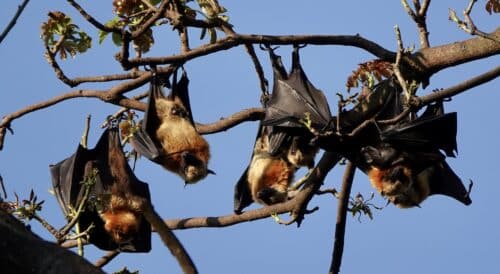
We spend over an hour with them, then Jonathan got a call that a farmer had found a Madagascar Ground Boa and wanted to know if we wanted to see it. Jonathan had put the word out with the locals that if they find any interesting wildlife to let us know. After seeing the boa, the farmer then proceeded to take us to different areas to look for chameleons and birds.
After this we went back to Camp Bandro for lunch and to relax. Deb and I decided to go back to Parc Etal with Jonathan to wildlife watch. We spent more time with the bats, and walked along some of the trails in the park. We also found several vacant buildings. One of them that was close to the flying fox colony had the smell of bats coming from it. Deb and I went in and found a small colony of Malagasy White-bellied Free-tailed bats in the roof.
Hoping to See Indris Near Zahamena National Park
In the afternoon Jonathan suggested that we go to the outskirts of Zahemena National Park to see Indris. We drove back to the town of Ambatondrazaka and left our belongings at the very basic Zama Meca hotel in town. Jonathan had organized several locals to take us on the back of motorbikes to an area where we could start hiking. The roads would have been impossible even with our four wheel drive.
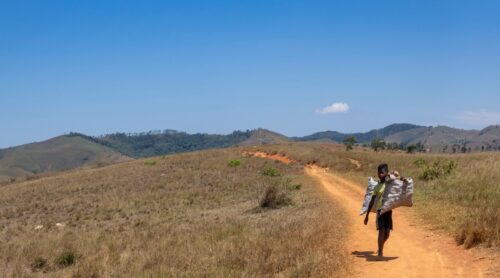
The first part of the hike was a VERY large hill straight up. This was at mid day with no shade in oppressive heat. After this, it was another 2.5 hours on trails straight up to the base of the forest again with no shade. The heat and hike up proved to much for me and I stopped at the base of the forest.
After walking down from the trails, we did get a witness a Famadihana ceremony, also known as “turning of the bones”. This ceremony takes place every 5-7 years. Villagers exhume family members from tombs to wrap them in fresh cloths and bring them to the village for a celebration before returning them to their tombs.
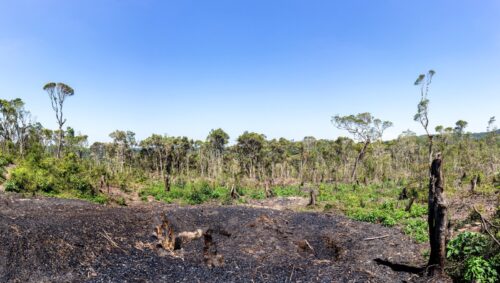
Angiolo was the only member of our group that made it deep enough in the forest to see the Indri. He reported back that most of the forest was being actively cut around him and them. We saw multiple people walking down the trail carrying logs from the forest. The destruction of the local forest from logging, slash and burn agriculture, and rice fields was astounding.

